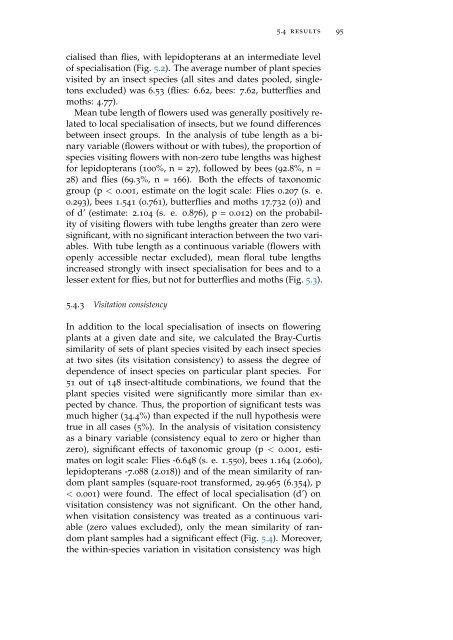Linking Specialisation and Stability of Plant ... - OPUS Würzburg
Linking Specialisation and Stability of Plant ... - OPUS Würzburg
Linking Specialisation and Stability of Plant ... - OPUS Würzburg
You also want an ePaper? Increase the reach of your titles
YUMPU automatically turns print PDFs into web optimized ePapers that Google loves.
5.4 results 95<br />
cialised than flies, with lepidopterans at an intermediate level<br />
<strong>of</strong> specialisation (Fig. 5.2). The average number <strong>of</strong> plant species<br />
visited by an insect species (all sites <strong>and</strong> dates pooled, singletons<br />
excluded) was 6.53 (flies: 6.62, bees: 7.62, butterflies <strong>and</strong><br />
moths: 4.77).<br />
Mean tube length <strong>of</strong> flowers used was generally positively related<br />
to local specialisation <strong>of</strong> insects, but we found differences<br />
between insect groups. In the analysis <strong>of</strong> tube length as a binary<br />
variable (flowers without or with tubes), the proportion <strong>of</strong><br />
species visiting flowers with non-zero tube lengths was highest<br />
for lepidopterans (100%, n = 27), followed by bees (92.8%, n =<br />
28) <strong>and</strong> flies (69.3%, n = 166). Both the effects <strong>of</strong> taxonomic<br />
group (p < 0.001, estimate on the logit scale: Flies 0.207 (s. e.<br />
0.293), bees 1.541 (0.761), butterflies <strong>and</strong> moths 17.732 (0)) <strong>and</strong><br />
<strong>of</strong> d’ (estimate: 2.104 (s. e. 0.876), p = 0.012) on the probability<br />
<strong>of</strong> visiting flowers with tube lengths greater than zero were<br />
significant, with no significant interaction between the two variables.<br />
With tube length as a continuous variable (flowers with<br />
openly accessible nectar excluded), mean floral tube lengths<br />
increased strongly with insect specialisation for bees <strong>and</strong> to a<br />
lesser extent for flies, but not for butterflies <strong>and</strong> moths (Fig. 5.3).<br />
5.4.3 Visitation consistency<br />
In addition to the local specialisation <strong>of</strong> insects on flowering<br />
plants at a given date <strong>and</strong> site, we calculated the Bray-Curtis<br />
similarity <strong>of</strong> sets <strong>of</strong> plant species visited by each insect species<br />
at two sites (its visitation consistency) to assess the degree <strong>of</strong><br />
dependence <strong>of</strong> insect species on particular plant species. For<br />
51 out <strong>of</strong> 148 insect-altitude combinations, we found that the<br />
plant species visited were significantly more similar than expected<br />
by chance. Thus, the proportion <strong>of</strong> significant tests was<br />
much higher (34.4%) than expected if the null hypothesis were<br />
true in all cases (5%). In the analysis <strong>of</strong> visitation consistency<br />
as a binary variable (consistency equal to zero or higher than<br />
zero), significant effects <strong>of</strong> taxonomic group (p < 0.001, estimates<br />
on logit scale: Flies -6.648 (s. e. 1.550), bees 1.164 (2.060),<br />
lepidopterans -7.088 (2.018)) <strong>and</strong> <strong>of</strong> the mean similarity <strong>of</strong> r<strong>and</strong>om<br />
plant samples (square-root transformed, 29.965 (6.354), p<br />
< 0.001) were found. The effect <strong>of</strong> local specialisation (d’) on<br />
visitation consistency was not significant. On the other h<strong>and</strong>,<br />
when visitation consistency was treated as a continuous variable<br />
(zero values excluded), only the mean similarity <strong>of</strong> r<strong>and</strong>om<br />
plant samples had a significant effect (Fig. 5.4). Moreover,<br />
the within-species variation in visitation consistency was high
















